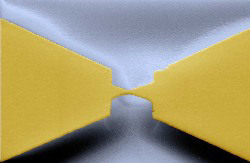Molecular Conductivity Takes Shape

Tomorrow’s electronics could consist of networks of individual molecules carrying tiny electrical currents–if researchers can determine precisely how a single complex molecule conducts electricity. In the 29 April print issue of PRL, a German team shows that an asymmetrically shaped molecule conducts differently depending on which direction the current flows. That means molecules differ from wires in the everyday world, which conduct equally well forward or backward, regardless of their shape. The experiment marks a step toward controlling single-molecule conductivity by designing the molecule.
In recent years, researchers have passed electricity through single molecules ranging from bulky stretches of DNA, to tiny spheres of carbon, to organic molecules just over a nanometer long. But they have only begun to explain how the properties of a molecule affect its ability to usher electrons along. Now Heiko Weber, Marcel Mayor, and their colleagues at the Karlsruhe Research Center in Germany have found a direct connection between shape and conductivity.
The researchers studied individual molecules spanning a tiny gap between two gold electrodes formed by breaking a gold bridge 50 nm wide and 50 nm thick. They used two different molecules, each 2 nm long, with a sulfur atom at either end. The first was symmetric–its left and right halves were mirror images. The second was asymmetric, and the asymmetry led to a slightly lopsided distribution of electric charge in the central part of the molecule. The sulfur atoms at the ends of a molecule delicately bonded to the two gold electrodes to form the electrical contacts.
When the team varied the voltage across symmetric molecules they found that more than half the time the changes in current for positive voltages mirrored those for negative voltages. (They believe the current changes weren’t always symmetric because a molecule sometimes bonded better to one of the contacts, and the conductivity of the two bonds would then change in different ways as the voltage changed.) But when the researchers varied the voltage across asymmetric molecules, the current changes were always asymmetric as the voltage ranged from positive to negative. So at least part of that asymmetry most likely arose from changes in the asymmetric distribution of molecular orbitals–Mayor says.
Others had seen asymmetric flow in similar experiments, says Jean-Philippe Bourgoin of CEA in Saclay, France, but those effects arose because of asymmetry in the electrode contacts to symmetric molecules. “This the first time that they’ve really conducted an experiment on two similar molecules so that they can see how the asymmetry of the molecules affects the measurement,” he says.
Even when working with the symmetric molecule, the Karlsruhe researchers were able to go from symmetric flow to asymmetric flow and back again by carefully moving the electrodes, notes Avik Ghosh of Purdue University in West Lafayette, Indiana. That shows that the researchers have exceptionally good control of the contacts between the sulfur atoms in the molecule and the gold electrodes, Ghosh says. However, Mark Ratner of Northwestern University in Evanston, Illinois, says that the unpredictable variations also show just how hard it is to manipulate these contacts. “They’ve got the best geometry control anyone has ever had,” Ratner says, “and still they don’t have great control.”
–Adrian Cho
Adrian Cho is a freelance science writer in Grosse Pointe Woods, Michigan.


